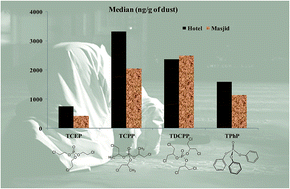Currently used organophosphate flame retardants determined in the settled dust of masjids and hotels of Saudi Arabia, a new insight into human health implications of dust exposure†
Abstract
Indoor settled dust particles are considered as an important source of human exposure to chemicals such as organophosphate flame retardants (PFRs). In recent decades the Kingdom of Saudi Arabia (KSA) has experienced tremendous growth in population, as a result the number of masjids has also increased significantly to provide sufficient space for the public to offer prayers. The hospitality industry in KSA is also expanding to cater for the ever-increasing number of pilgrims visiting the two holy cities of the kingdom. However, limited data are available on the indoor pollution of masjids and hotels. In this study, PFRs were analyzed in the settled dust collected from various hotels and masjids of Jeddah, KSA. Tris(1,3-dichloro-2-propyl) phosphate (TDCPP) and tris(1-chloro-2-propyl) phosphate (TCPP) were the major PFRs in masjid (median = 2490 and 2055 ngg−1) and hotel (median = 2360 and 3315 ngg−1) dust, respectively. A public health risk assessment was carried out by determining the incremental lifetime cancer risk (ILCR), and daily exposure via dust ingestion, inhalation, and dermal contact of PFRs. The calculated daily exposure via dust ingestion was well below the reference dose (RfD) values, and also the calculated hazardous quotient (HQ) and carcinogenic risk were well below the risk mark. However, the ILCR for PFRs was below the reference values of USEPA, which suggested that long-term exposure to these chemicals has a limited cause for concern. The study showed that the general public is exposed to PFRs in the studied microenvironments and the major exposure routes are dermal contact and ingestion.



 Please wait while we load your content...
Please wait while we load your content...